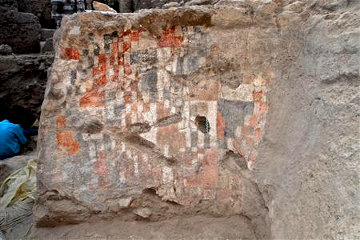Cosmological Chequer Board
The astonishing Neolithic city of Catal Huyuk in Turkey has long been known for its beautiful pottery and its complex housing arrangements. Back in 2008 French archaelogists of the Centre National de Recherche Scientifique, working in northern Syria, uncovered what may the world's oldest house painting.
Directed by Eric Coqueugniot, the team has been working at Djade al-Mughara, where they uncovered a Neolithic settlement whose inhabitants do not appear to have invented agriculture but instead lived as hunter-gatherers. Mind you, why would anyone go in for the hard life of a farmer if the pleasures of the chase were all they needed for sustenance? It would be a mistake to assume that the lack of agriculture indicated that these people were primitive or unsophisticated - and the painting appears to bear this out.

| |
| This abstract chequer-board pattern speaks to the French of a "cosmological world view". |
What the archaeologists have found is an underground circular room 24' in diameter which had a single pillar in the centre to support the roof poles. The pillar and the walls were decorated with a geometric pattern of squares that reminded some of the team of the modern painter Paul Klee, though less artistic members dubbed it a "chequer board". The colours are red from crushed haematite, black charcoal and white lime.
The size of the room as well as its underground location suggest to the excavators that it was not a domestic building but points towards a ritual use and, being French, they have come up with a wonderful theory about how a chequerboard "marks the borders of the spiritual realm within a world-view that is cosmologically defined". Perhaps it sounds better - and possibly even makes sense - in French.
Personally I am happy to consider that the room may indeed have had a ritual purpose. People commonly went to considerable lengths to beautify their places of worship. I doubt, however, that the pattern had any importance other than the aesthetic and is just as likely to reflect a desire not to depict any figure that could be worshipped. An abstract pattern would not "make an image of anything in heaven above nor in the earth beneath nor in the waters under the earth", to quote the Second Commandment of the Decalogue.
The one thing we can be sure of is that these Neolithic people were quite sophisticated; they constructed a special place for worship, they decorated it, they used common materials for an uncommon purpose, and so on. A popular radio programme here in Britain is called "Desert Island Disks" and invites various celebrities to imagine being cast away on a desert island. The core of the programme is the celebrity's choice of music to accompany his - or her - period of exile, but I wonder how many of these modern people, faced with the struggle to keep alive on this putative desert island, would take the time - or have the energy - to decorate their shelter?
Unfortunately the painting was taken to the Aleppo Museum for preservation and there is no word of its fate in the battles that have left large parts of Aleppo, including its famous covered market, in ruins.
© Kendall K. Down 2014





